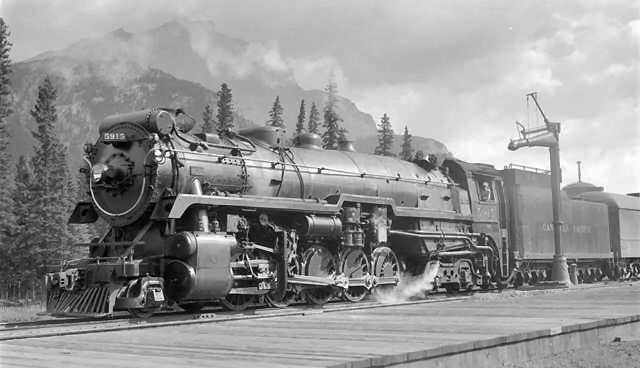- Selkirk locomotive
Infobox Locomotive
name=Canadian Pacific ‘Selkirk’ locomotives
powertype=Steam
caption=T1a Selkirk atBanff, Alberta in 1938.
builder=Montreal Locomotive Works
builddate=1929 (20); 1938 (10); 1949 (6)
ordernumber=Q-415 (T1c)
serialnumber=67921–67940 (T1a)
69110–69119 (T1b)
76221–76226 (T1c)
whytetype=2-10-4
uicclass=1'E2'h
gauge=RailGauge|ussg
driversize=convert|63|in|m|3|abbr=on
weightondrivers=convert|368000|lb|t|abbr=on (T1a/T1b)
convert|369000|lb|t|abbr=on (T1c)
weight=convert|453000|lb|t|abbr=on (T1a)
convert|447000|lb|t|abbr=on (T1b)
convert|449000|lb|t|abbr=on (T1c)
cylindercount=Two, outside
cylindersize=25½ × 32 in (648 × 813 mm) (T1a)
25 × 32 in (635 × 813 mm) (T1b/T1c)
boilerpressure=convert|250|psi|MPa|2|abbr=on|lk=on (T1a)
convert|285|psi|MPa|2|abbr=on (T1b/T1c)
tractiveeffort=convert|78000|lbf|kN|2|abbr=on|lk=on
railroad=Canadian Pacific Railway
railroadclass=T1a (20), T1b (10), T1c (6)
roadnumber=5900–5919 (T1a)
5920–5929 (T1b)
5930–5935 (T1c)
locale=Western Canada
preservedunits=Two, 5935 and 5931
disposition=Two preserved, remainder scrapped. The Selkirk locomotives were 36steam locomotive s of the2-10-4 wheel arrangement built forCanadian Pacific Railway byMontreal Locomotive Works ,Montreal, Quebec ,Canada .The first of these large engines with 2-10-4
wheel arrangement were built in July 1929. Altogether twenty were constructed before the end of the year bearing numbers 5900 to 5919. TheCanadian Pacific Railway 's classification was T1a. These locomotives weighed convert|375|ST|lk=on fully loaded. They were the largest and most powerful non-articulated locomotives in the British Empire.Fact|date=August 2008 Named after the Selkirk range of mountains they crossed.Montreal Locomotive Works built another ten of these successful mountain locomotives during November and December of 1938. The Canadian Pacific Railway assigned them T1b class. They were numbered from 5920 to 5929. Modifications led the T1b to be ten tons or tonnes lighter while increasing steam pressure from convert|275|psi|lk=on to convert|285|psi. A further six Selkirks classed T1c were built by the Montreal Locomotive Works shop in 1949. They were the last
standard gauge steam locomotives built inCanada for a Canadianrailroad . They were the same as the T1b except for a few refinements, including two cross-compound air compressors to speed recharging of the air brake system. They were all equipped with boosters (some shortly after being built) and all were built as oil burners. The tenders held convert|12000|impgal|lk=on of water and convert|4100|impgal of fuel oil. They had to be equipped with two pair of six wheel trucks because the total tender weight was convert|148|ST.These last Selkirks were taken out of service in 1959. All but two were scrapped. None of the earlier T1a class locomotives were preserved. Their heavier looking, non-streamlined appearance, were better examples of the heavy mountain steam power look. The 5935 is preserved in Delson,
Quebec while the 5931 (renumbered 5934) is in Calgary's Heritage Park. These later T1b and T1c class locomotives were semi-streamlined and were painted with CPR tuscan red panels along their running boards and on the tender sides with gold leaf border trim.The locomotives were assigned to handle both freight and passenger trains westward between Calgary and Revelstoke a distance of convert|262|mi. The Laggan Subdivision covered the first convert|137|mi and included the
Field Hill and the famousSpiral Tunnels ; while the second, the Mountain Subdivision covered the remaining convert|126|mi which included the famousRogers Pass and theConnaught Tunnel . The Grades encountered were a maximum of 2.2 per cent (1 in 45), with curves of 12 degrees or convert|480|ft radius. Rated at convert|78000|lbf tractive effort, on the lesser grades they could haul convert|1050|ST unassisted and without the booster cut-in. Thebooster engine added an additional convert|12000|lbf|kN|abbr=on of tractive effort up to a maximum of convert|20|mph. Due to their extreme weight they could not proceed to Vancouver. They were also used for convert|23|mi west of Revelstoke to Taft assisting freight and passenger trains up the steep grade to the Three Valley Gap at Clanwilliam.When diesels began operation between Calgary and Revelstoke in the early 1950s the Selkirks were assigned to work the
Brooks, Alberta and Maple Creek,Saskatchewan subdivisions between Calgary and Swift Current,Saskatchewan . They were also used to haul freight trains north of their new Alyth terminal as far asEdmonton, Alberta .References
* C.P.Atkins, B.Sc. "Loco Profile 35 Canadian Pacific Selkirks" Profile Publications Ltd. Windsor, England 1973.
* "CPR Form M.P.330 Classification and Dimensions of Locomotives" Revised February 1,1947 Issued by the Chief of Motive Power & Rolling Stock
Wikimedia Foundation. 2010.
